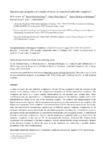| dc.contributor.author | Sy, Mohamadou | |
| dc.contributor.author | Esteban-Gómez, David | |
| dc.contributor.author | Platas-Iglesias, Carlos | |
| dc.contributor.author | Rodríguez-Rodríguez, Aurora | |
| dc.contributor.author | Tripier, Raphaël | |
| dc.contributor.author | Charbonnière, Loïc J. | |
| dc.date.accessioned | 2018-11-30T11:52:11Z | |
| dc.date.available | 2018-11-30T11:52:11Z | |
| dc.date.issued | 2017-04-10 | |
| dc.identifier.citation | Sy, M., Esteban‐Gómez, D., Platas‐Iglesias, C., Rodríguez‐Rodríguez, A., Tripier, R. and Charbonnière, L. J. (2017), Spectroscopic Properties of a Family of Mono‐ to Trinuclear Lanthanide Complexes. Eur. J. Inorg. Chem., 2017: 2122–2129. | es_ES |
| dc.identifier.issn | 1434-1948 | |
| dc.identifier.issn | 1099-0682 | |
| dc.identifier.uri | http://hdl.handle.net/2183/21415 | |
| dc.description.abstract | [Abstract] A series of mono‐, di‐, and trinuclear complexes of Eu and Tb was designed to study the influence of the number of Ln emitting centers on the luminescence properties of discrete polynuclear complexes. The complexes are based on a cyclen scaffold, functionalized by two picolinic acid pendant arms. These coordinating units are separated by a 1,3‐dimethylbenzene spacer for the dinuclear complex and a 1,3,5‐trimethylbenzene bridge in the case of the trinuclear complex. The synthesis and characterization of the ligands are presented, together with the preparation and spectroscopic characterization of the complexes. The luminescence properties of the complexes were determined by UV/Vis absorption spectroscopy and steady‐state and time‐resolved luminescence spectroscopy in buffered aqueous solutions. Comparison of the electronic absorption spectra showed that the absorption properties can almost be considered as extensive parameters within experimental error, as expected for electronically non‐conjugated systems. A small drop of both the excited state luminescence lifetimes and the luminescence quantum yields was observed for the trinuclear complexes in the case of Tb. To understand this behavior, theoretical HF (Hartree–Fock) calculations were performed for the three complexes. Models indicate that the average intermetallic distance in the dinuclear complex is almost the same as in the trinuclear one, disfavoring a possible distance dependence of the observed phenomena. | es_ES |
| dc.description.sponsorship | Francia. Agence Nationale de la Recherche; ANR P2N 2012 | es_ES |
| dc.language.iso | eng | es_ES |
| dc.publisher | Wiley | es_ES |
| dc.relation.uri | https://doi.org/10.1002/ejic.201601516 | es_ES |
| dc.rights | This is the peer reviewed version of the following article: Sy, M., Esteban‐Gómez, D., Platas‐Iglesias, C., Rodríguez‐Rodríguez, A., Tripier, R. and Charbonnière, L. J. (2017), Spectroscopic Properties of a Family of Mono‐ to Trinuclear Lanthanide Complexes. Eur. J. Inorg. Chem., 2017: 2122–2129, which has been published in final form at https://doi.org/10.1002/ejic.201601516. This article may be used for non-commercial purposes in accordance with Wiley Terms and Conditions for Use of Self-Archived Versions. | es_ES |
| dc.subject | Lanthanides | es_ES |
| dc.subject | Luminescence | es_ES |
| dc.subject | Polynuclear complexes | es_ES |
| dc.subject | Macrocyclic ligands | es_ES |
| dc.subject | UV/Vis spectroscopy | es_ES |
| dc.title | Spectroscopic properties of a family of mono‐ to trinuclear lanthanide complexes | es_ES |
| dc.type | info:eu-repo/semantics/article | es_ES |
| dc.rights.access | info:eu-repo/semantics/openAccess | es_ES |
| UDC.journalTitle | European Journal of Inorganic Chemistry | es_ES |
| UDC.volume | 2017 | es_ES |
| UDC.issue | 14 | es_ES |
| UDC.startPage | 2122 | es_ES |
| UDC.endPage | 2129 | es_ES |






